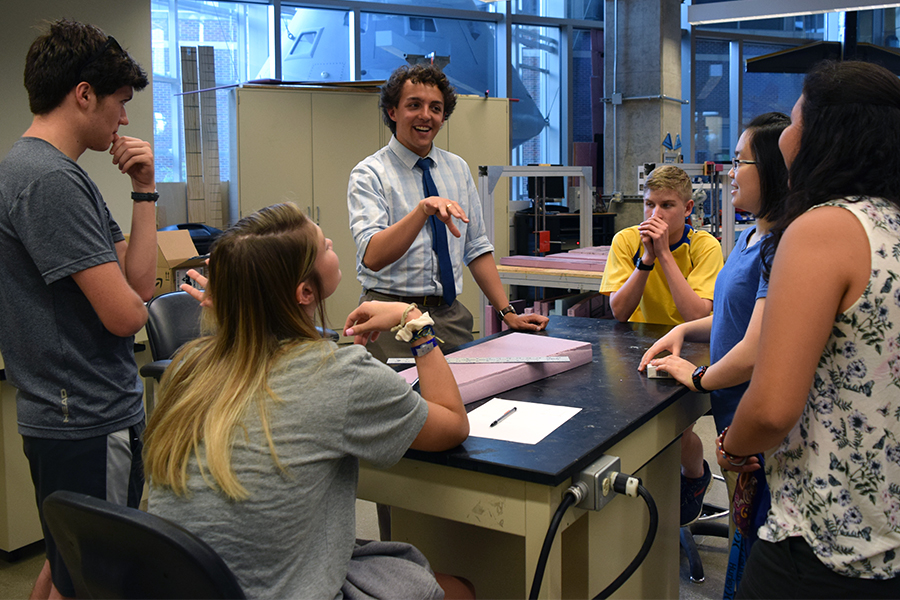'Project HALO' provides experiential learning for local high school students

A group of local high school students is learning how to design, build and, hopefully soon, fly a high-altitude balloon with a payload, thanks to a Ph.D. student in the School of Aeronautics and Astronautics.
“Project HALO” — High Altitude Lafayette Observatory — will measure some of the basic properties of the atmosphere to see if it’s possible to detect variations in the concentration of CO2 at different altitudes and over different types of land.
Ten high school students from Harrison, McCutcheon and West Lafayette initially met in mid-June. They’ve gathered twice a week, Wednesday evenings and Sundays.
“This is the real deal,” said Talal Zaim, who will be a senior at West Lafayette High School in the fall. “At first, I was like, ‘This is going to be somewhat easy.’ But as I dived down, head first, it turned out to be much more difficult. I’ve never done anything of this magnitude or of this caliber.”

Last summer, Geoffrey Andrews taught a two-week course on systems engineering, as it applied to spacecraft, for the Gifted Education Research & Resource Institute. When an opportunity to teach this summer in that same program didn’t materialize, Andrews had an idea: He’d recruit students and teach anyway.
Andrews already had developed a proposal for a short course with an applied example of aerospace engineering concepts — the high-altitude balloon — and received funding from the Indiana Space Grant Consortium and AAE. He found students by emailing all the principals and science teachers at high schools in Lafayette and West Lafayette.
“I thought it’d be a neat way to bring together students that might not otherwise get to meet each other or work together from different high schools in the area,” says Andrews, who will be starting the third year of his Ph.D. this fall under advisor Jonathan Poggie, an associate professor in AAE. “The overall goal is to give them not only just the hands-on learning experience but something that is quite literally above and beyond in what they might be able to do normally in a high school science or engineering class.
“I did lots of neat projects and building stuff when I was in high school, and I would have loved to do something like this. So it’s just a way to provide what I hope will be an interesting, informative and educational opportunity to kids who perhaps are in the shoes I was in.”
It’s very much been a student-led project — Andrews likes to call it “experiential learning” — because the students chose the payload for the balloon and devised the design concepts. Andrews largely has provided guidance and filled in gaps when students didn’t know how to execute their ideas.

The payload is a small computer with sensors to measure atmospheric temperature, pressure and carbon dioxide concentration, as well as an accelerometer to measure the package’s motion. It also has a GPS to beam its position back to the ground so that the team can recover it.
The group broke into teams to work on different areas of the project, including structures, telecommunications and the science payload. On July 10, work started on the physical construction of the payload with students wiring sensors on the breadboard, programming the flight computer and cutting insulation foam using a CNC hot wire machine to assemble into a payload enclosure.
“It’s a fairly comprehensive project,” Andrews says.
Grace Estep (Harrison), Tyler Horton (Harrison), Noah Jewell (McCutcheon), Song Kim (Harrison), Isaac Leichty (West Lafayette), Riley Owen (Harrison), Shianne Switzer (McCutcheon), Marlene Tedy-Gabriel (Harrison), Anderson Xu (West Lafayette) and Zaim (West Lafayette) would like to showcase their work July 20 during Purdue’s Apollo 11 50th anniversary celebration.
But if that date doesn’t sync for launch, they’ll eagerly await whatever date works — and be happy to celebrate the accomplishment together.
“I realized there’s a lot of other people who share similar interests as me,” says Zaim, who would like to study aeronautics and astronautics at Purdue. “I thought maybe I was going to be alone, but there’s a lot of local people who want to do the same thing — they want to launch a balloon. Some of us are doing it just for fun. Some of us want to learn the engineering process. I think everybody is interested in the aerospace side of it.
“I think all of us are going to be really proud of it. We created something on our own. Whatever happens, even if it crashes and doesn’t work out, I think we’re still going to be happy we got something done.”
